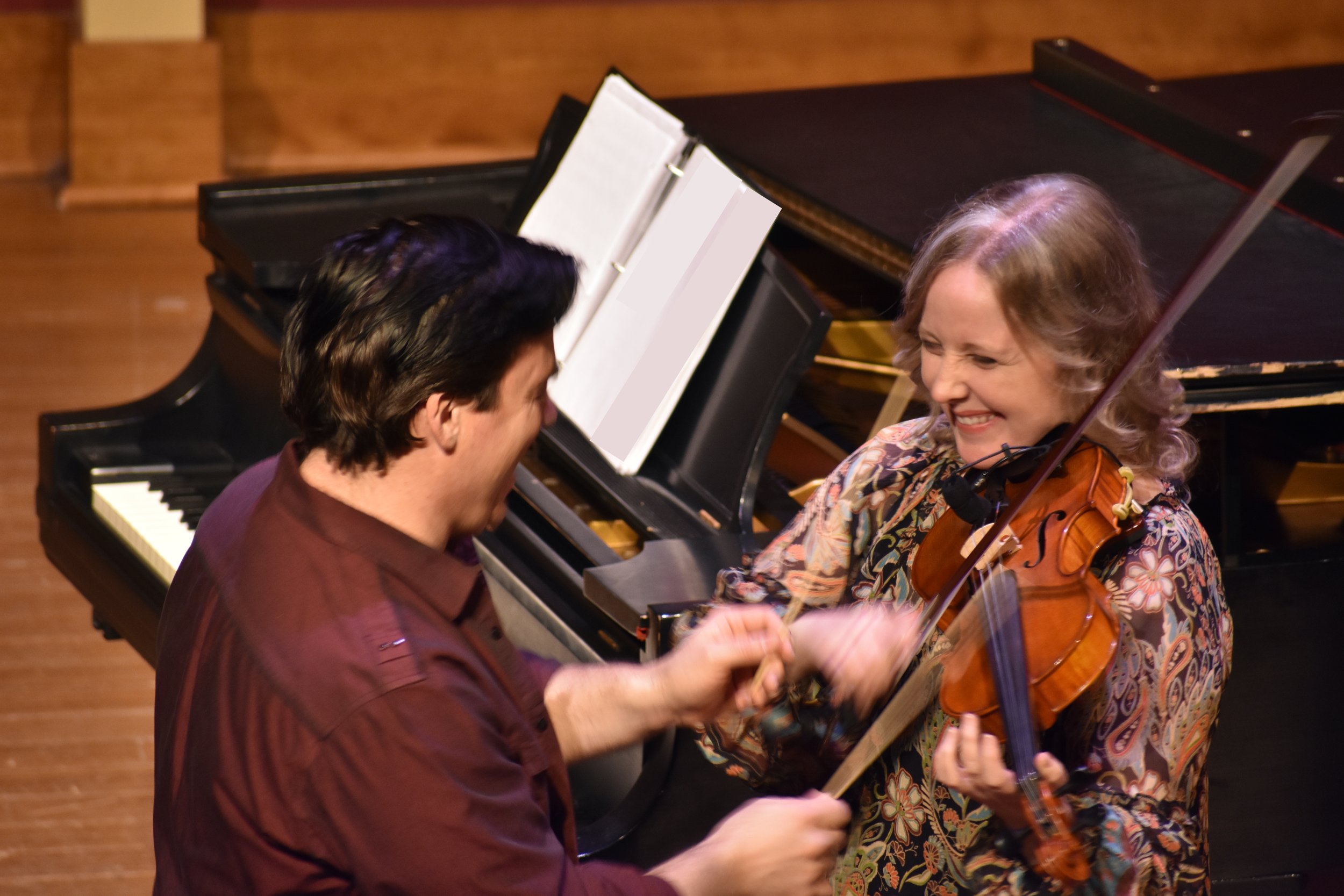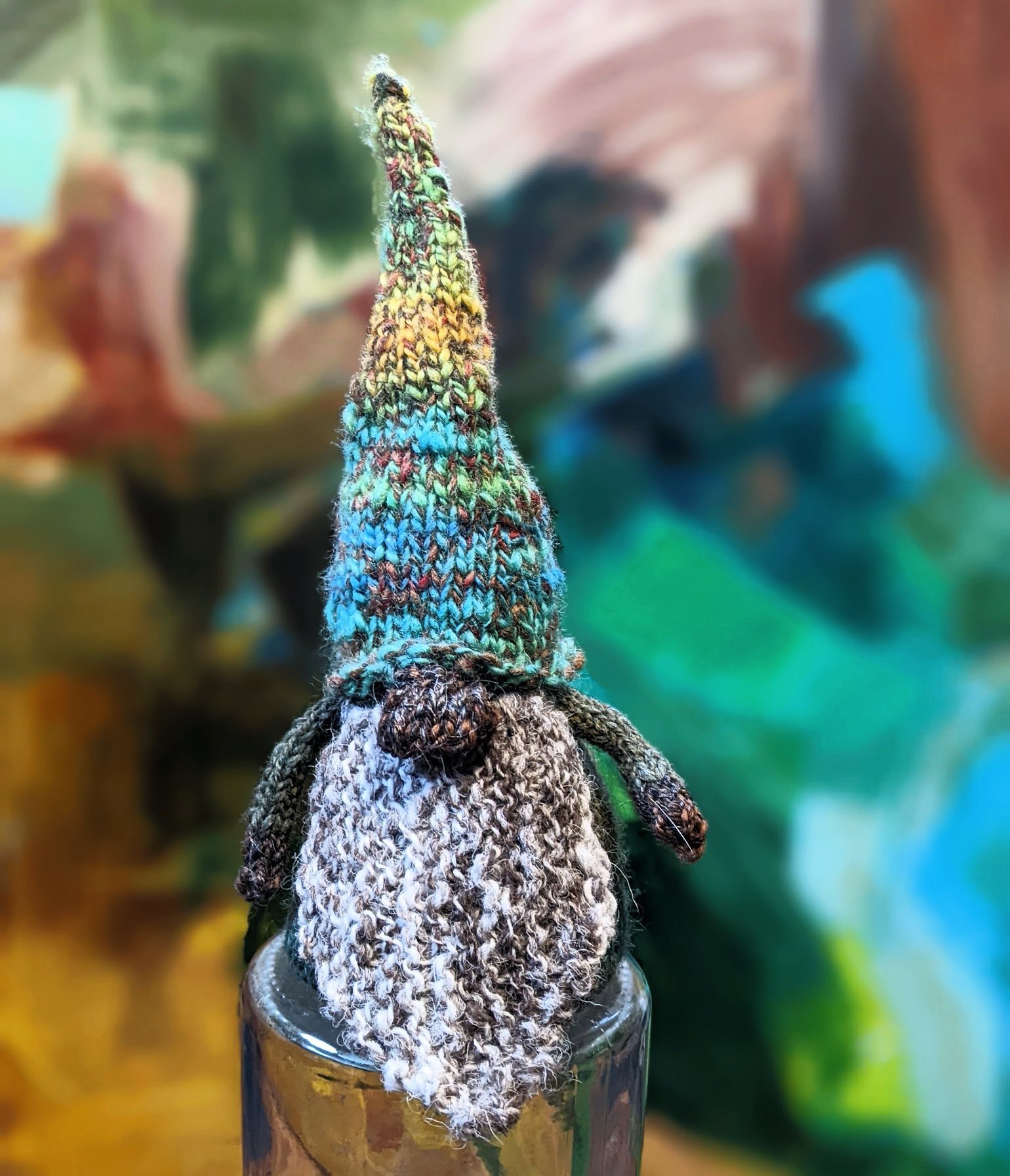KNITTING a new reel feat. Renee Stauffer: "THE CASTLE WHEEL"
OFFICIAL MUSIC VIDEO: Travel through time with a reel that knits together Quebec, Cajun, Acadian and African American fiddle traditions. This edition of "Fiddling With Traditions" features the work of spinner/knitter Renee Stauffer.
TAUNY [Traditional Arts in Upstate New York] presents Gretchen Koehler's "Fiddling With Traditions" - a new fiddle suite of handcrafted tunes inspired by North Country artists. "Fiddling with Traditions" is made possible by the New York State Council on the Arts with the support of the Office of the Governor and the New York State Legislature.
Renee Stauffer dyed a skein of Navajo Churro with Creeping Charlie, dark purple iris, and rusty bolts. (Courtesy of Renee Stauffer)
FIDDLING WITH TRADITIONS
After a creative pause during the pandemic, I was in search of new ways to think about approaching music. Early in 2022, with the support of TAUNY [Traditional Arts in Upstate New York] , I conducted interviews with artists from a variety of media from rug braiding to silversmithing. Over the course of they year, I composed a new suite of tunes, as well as wrote articles and produced a series of music videos featuring these extraordinary folks. A musical concert is scheduled for October 22 in Northern New York followed by an exhibit of the “Fiddling With Traditions” artists on display in TAUNY’s Upstairs Gallery in November.
~Gretchen
Freshly spun wool by Renee Stauffer. (Courtesy of Renee Stauffer.)
(Courtesy of Renee Stauffer.)
OH FIDDLESTICKS!!
Most folks don’t know that “fiddlesticks” is an actual fiddle playing technique. As the fiddler plays, a partner uses sticks to drum out an accompaniment along the fiddle fingerboard. Though not widely used, I was lucky enough to be introduced to it 25 years ago by Acadian fiddler Lewis Cyr who lived not far from me in upstate New York. Whenever we were together, Lewis would pull out the pair of chopsticks that he kept tucked in his fiddle case and give me a wink. I knew it was time to cross tune my fiddle and get ready to play. Everyone loved it at our jam sessions. It was such a great sound that I showed it to pianist Daniel Kelly so we could share it at our performances.
“Most folks don’t know that “fiddlesticks” is an actual fiddle playing technique using sticks to drum out an accompaniment along the fiddle fingerboard.”
Daniel Kelly & Gretchen Koehler performing the “Fiddlesticks.” (In-Sil Yoo photo)
Before Lewis showed me the fiddlesticks, I had only thought of it as a Cajun fiddle tradition. With a little research, I quickly learned that the Acadians of the Northeastern US and Canada were historically connected to Louisiana. Since some folks use knitting needles as their fiddlesticks, I knew I wanted to partner with a knitter so I could explore the tradition further, which brings me to spinner and knitter, Renee Stauffer.
“Since some folks use knitting needles as their fiddle sticks, I knew I wanted to partner with a kntter so I could explore the tradition further. ”
Spinner & knitter Renee Stauffer. (Koehler photo)
RENEE STAUFFER Spinner & Knitter
Local folks have heard of Renee Stauffer through the Stauffer Dairy Farm in Nicholville, NY. For the past 12 years, I have known Renee as the mom who sits in my fiddle studio and knits while her three children have lessons. Her kids always wear warm, beautiful socks, hats and mittens. Her eldest daughter often wears fashionable knit tops, shawls and cowls. Renee has fun with her knitting, adding whimsy to anything from funky lampshade to little knit gnomes.
Fiddler Lydia Stauffer along with her puppy Azure, modeling her mother’s knit tops. (Koehler photo.)
Renee Stauffer’s “Guillaume the Gnome” who is a fixture at Koehler’s Fiddle Studio. (Koehler photo)
GIFTS
Renee does not sell her work, rather she gives it away to lucky friends in the community, as well as those in need of warm clothing. She is self-taught and one of those people that, for her whole life, has been good at making things with her hands. As a knitter, she is part of the long tradition from around the world of people who have looped and intermeshed yarn into warm textiles.
Brightly dyed wool by Renee Stauffer. (Koehler photo.)
Watching the motion of the double treadle inspired Koehler’ Quebecois foot percussion. (Koehler photo)
SPINNING
Watching Renee spin wool on her small “Castle” spinning wheel was so much fun. With wool that she has dyed, she gently touches the cotton candy tufts of raw wool to the leader string with her finger tips. I could hear a certain “groove” in my head as I watched the spinning motion. When I noticed her two feet gently pumping the double treadle I knew immediately I wanted to include some Quebec foot percussion, aka podorythmie, to mimic her feet!
“When I noticed her two feet gently pumping the double treadle I knew immediately I wanted to include some Quebec foot percussion, aka podorythmie, to mimic her feet!”
Knit socks made by Renee Stauffer. (Courtesy of Renee Stauffer.)
Renee Stauffer dyed skeins of Merino with beet juice, dark purple iris, tea, creeping charlie and rusty bolts. (Courtesy of Renee Stauffer.)
Smokey enjoying a bed full of Renee Stauffer’s knitting projects. (Koehler photo)
HISTORY
Renee loves history and the 1,000 year of knitting around the world has offered her a lot to explore. From cotton socks found in the Egyptians pyramids, to Viking men’s knitting guilds to current day Navajo transferring pottery patterns into knitting patterns, learning about knitting serves to deepen her cultural and global awareness.
Renee also mentioned that she finds knitting very meditative and calming during times of stress. I’ve read that knitting has been proven as a stress reducer. No wonder it has endured for centuries!
Handspun wool by Renee Stauffer. (Koehler photo.)
Renee Stauffer’s “Detained Heart Project” featured 2,000 handmade hearts. The installation brought attn to the detention of migrant children. (Potsdam, NY, 2019. Photo courtesy of Todd Moe.)
“CHOOSE LOVE.” Crocheted yarn graffiti by Renee Stauffer. (Courtesy of Renee Stauffer.)
SOCIAL JUSTICE
As her friend, I can easily say that knitting is one of Renee’s “super powers.” She knits scarves to hand out to folk waiting in cold voting lines. She “yarn storms” welcoming rainbows around town. She purchases supplies from socially conscious companies. She only uses patterns from those who pay their employees fair wages and give appropriate cultural credit to the designs. She is motivated by current events. In 2019 she brought attention to the detention of child migrants separated from their families by collecting 2,000 handmade hearts from knitters & crocheters from around the world for an installation surrounding her church in Potsdam, NY. (Click to hear NCPR story.) Among her many social causes, Renee is an outspoken advocate for the Black Lives Matter movement.
A pile of wool ready to be prepped for the spinning wheel. (Koehler photo)
BLACK FIDDLE TRADITIONS
Circling back to the fiddle sticks… when I was researching fiddle sticks for this project, I read one sentence in Wikipedia that this technique may have been used on plantations. When I did digging, I could only find a few vague mentions of enslaved people using this technique.
This research did lead me, however, to Phil Jamison, a square dance caller from North Carolina who wrote the book “Hoedown, Reels and Frolicks” which talks about race, culture and identity as it relates to Appalachian Mountain Traditions. I knew of his research from a lecture he gave at TAUNY in 2010 about black fiddle traditions.
“Hoedowns, Reels, and Frolics” by Phil Jamison
I learned that many enslaved people were fiddle players. For nearly 100 years, they fiddled at square dances, either for black dancers or as the fiddle band for the white plantation owners. Jamison shared that the actual “calling out” of the dance moves - an essential part of American modern dances- was first introduced by black square dance musicians. For years, it had been the norm for a “dance master” to come prep the dancers with lessons, just as had been done in Europe. In contrast, “calling” out the moves while the music was playing allowed a room of folks to dance without those formal lessons. (To learn more, click to African influences on American Square Dances.)
As I read more, it became clear that Renee was the perfect person to help me “knit” together the history of fiddlesticks, and raise awareness to the importance of black fiddling in America.
“It became clear that Renee was the perfect person to help me “knit” together the history of fiddlesticks, and raise awareness to the importance of black fiddling in America.”
Knitting by Renee Stauffer that inspired the color and texture of the new fiddle tune, “The Castle Wheel.” (Koehler photo.)
GRATITUDE
I want to take a moment to formally express gratitude. I spend a lot of time thinking about the fiddlers who came before me, even though it is impossible to know who they all were. As I play my 300 year old violin, I am aware that history sits right under my chin. Hundreds of years of musicians have passed down knowledge that made it from their hands to my hands. Now it travels from my hands to my students’ hands. This is remarkable to me and I am humbled to be part of this fiddling tradition.
“Hundreds of years of musicians have passed down knowledge from their hands to my hands.. Now it travels from my hands to my students’ hands. I am humbled to be part of this fiddling tradition.”
LISTENING GUIDE
We open with a spinning wheel as we travel back in time to honor the first fiddle stick players who drummed out a rythm on the fiddle. The fiddle melody evokes some of Renee’s favorite stitches. The garter stitch, one of the most versatile, that can be repeat 1000 times to make a simple hat. The tune also contains a cable knit, a twisty stitch, as heard by the fiddle bow crossing the strings like strands of yarn. This tune contains a bobble, a fun pop of 3D knitting that translates into spiccato bowing that leaps right off the strings.
When the melody is joined by the piano, the “color work” begins. As the fiddle continues to play the same repetitive “stitches,” the piano will color them differently as the piano layers on different chords. All the while, the fiddlers taps out the Quebecois foot percussion/podorythmie on the floor in the same way Renee’s feet rock back and forth to keep her spinning wheel in motion.
Named for her style of spinning wheel, we present the “The Castle Wheel.”
To Renee- As always, spending time with you is a pleasure. Thank you for being an inspiration to me, both as a musician and as a human being. I learned so much researching the African American fiddle traditions with you. Thank you again for being part of “Fiddling With Traditions.” ~Gretchen
Gretchen Koehler filming Fiddling With Traditions music video. (Koehler photo).
NCPR interview with Fiddler Gretchen Koehler and one of the featured artists in Fiddling With Traditions Artists, spinner Renee Stauffer. Northern Light Link



















